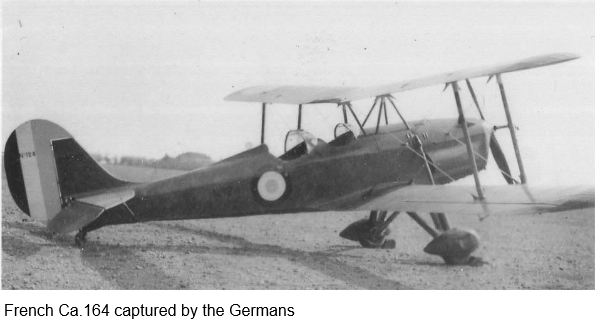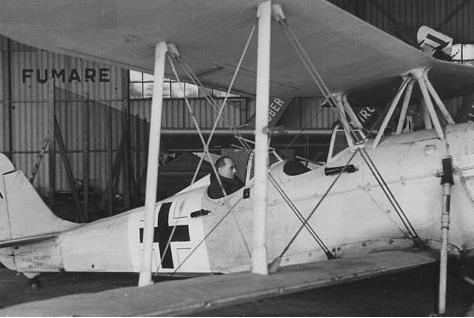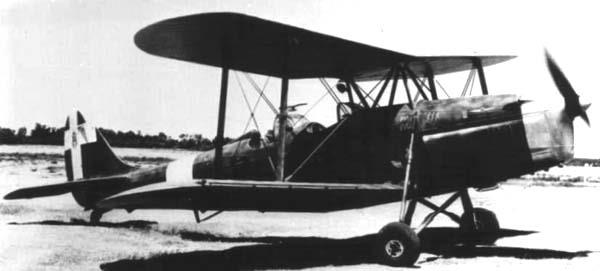The Caproni Ca.164 was a single-engine biplane, with an inverted sesquiplana configuration, produced by the Italian company Caproni Aeronautics in the Predappio plants, near Forlì, in the 1930s.
Conceived to replace the previous Ca.100 in flight training schools, it did not have the same success but was nevertheless made in 380 copies and used by the Regia Aeronautica and by the French Armée de l'air.
At the beginning of the second half of the thirties the Ministry of Aeronautics issued a specification for the supply of a new model of training aircraft to replace the Ca.100 in service in the first-period flight schools of the Regia Aeronautica. The competition was attended by Caproni, which proposed a development of the previous model, and the Società Anonima Industrie Meccaniche Aeronautiche Navali (SAIMAN), which presented its Saiman
The design of the new model was entrusted to Eng. Raffaele Conflenti, who decided to start an update of the successful Ca.100, with an increase in the curb weight and the adoption of a more powerful engine. Submitted to the Superior Experience Studies Directorate in May 1937, it was later developed assuming different engines and a casualty carrier version was also proposed, with a front position for the pilot and a rear position for a stretcher with porthole.
The Caproni plant in Predappio (the birthplace of Benito Mussolini), for its survival relied on the production of Ca.164, replacing the production order under license of the Savoia-Marchetti S.M.81, which is about to be completed. The prototype of the Ca. 164 made its first flight over the Forlì field (where the planes were transported by road trains) on November 17, 1938. The General Staff asked for a comparative study between the Ca.164 and the Breda Ba.25 / D- 2, which shows that the Predappio aircraft has better absolute speed and maximum load characteristics, but is lower in climb speed and robustness. The Caproni foresees the installation of a 7.7 mm machine gun synchronized with the propeller and a variant for the launch of clips, with a single pilot.
The first Ca.164 was evaluated for military use at the Experimental Flight Department, at the Superior Studies and Experiences Directorate of Guidonia, from December 1938 and initially obtained favorable opinions. On December 28, the opinion of the General Staff Office was instead negative: numerous changes must be made to the prototype and strong unknowns remain about the behavior of the aircraft once the airframe has been strengthened and the wingspan decreased, as required for use in aviation schools for first level courses. The construction of a dozen specimens to be evaluated in operational use is authorized.
Without taking these indications into account, General Giuseppe Valle, Undersecretary of State for the Air Force, independently sent an order for 50 specimens of Caproni Ca.164 Predappio.
The plane was modified according to the indications of the General Staff and subjected to new tests: on 8 March 1939 the same office reiterated that the Ca.164 was not suitable for replacing the Breda Ba.25 in first-level schools because it had insufficient improvements. compared to this model. Even the use for acrobatic schools does not seem feasible for the Ca.164, which has far less qualities than the Saiman 200, created for this specialty. The most suitable role for the Ca.164, which is easy to operate, appears to be that of a liaison plane, on which to carry out the flight hours required by the pilots. For this use, a further 150 specimens are ordered to equip all the flight schools and replace the Caproni Ca.100, which were sold to the pre-military flight schools.
In July 1939, while an example was being tested at the Experimental Center of Guidonia, mass production began in Predappio. As soon as they were presented to the Flight Schools, in the autumn of 1939, the first Ca.164s were disbarred at the end of the year. On February 29, 1940, in a flight to set up the plane, the test driver Marshal Drigana died, crashing after a screw.
Meanwhile, in January, France ordered 100 copies of the Ca.164, in a political attempt to reconnect with Italy. Production continues and up to April about 70 aircraft are delivered to France (16 aircraft were recovered from Italy in 1943 after the Italian occupation of southern France).
On March 26, 1940, a Commission chaired by General Francesco Pricolo asked the General Staff for a study on the best use for the Ca.164: it was decided to use these planes for the connection in the bombing departments, to which they were attributed, from 1941, until to become the classic aircraft used for this purpose.
On 24 June 1941 the Ca.164 was proposed by General Bernasconi and accepted by a Commission directed by General Pricolo, for the night flight training of the student fighter pilots: consequently, specimens of the Ca. 164 were attributed to some departments of this specialty. On July 14, 1942, the armed version of the Ca. 164, with machine gun, was taken into consideration. About 30 specimens are modified in this sense. In February 1943, at the Construction Center
The Ca. 164 was a two-seater biplane, with wooden structure wings of inverted sesquiplana configuration, covered in the leading edge with plywood and painted canvas for the other parts. The flaps (metal structure covered in canvas) were placed on the upper wing, while the ailerons (wooden structure, canvas covering) were arranged in the lower wing. The rear floors were braced with metal cables and made with wooden structures covered with plywood and canvas.
The two-wheeled trolley was fixed and the wheel was swiveling. The fuselage was made of welded steel tubes and lined with duralumin and canvas. The pilot stations were in tandem, in open cockpits, with dual controls and essential instrumentation. The propeller was a fixed-pitch two-blade wooden propeller. The 135-liter tank was placed in the fuselage between the engine and the first cockpit.
The main use of the Ca. 164 was as a liaison aircraft for the bomber squadrons of the Regia Aeronautica. In this role he was present on almost all the fronts that saw the Regia Aeronautica engaged in the Second World War, from Africa to Belgium to Albania. In some cases, it was also used to carry out attacks on the ground. From 1941, it was used for training in night flying and given to some hunting departments. The plane was also used by the Republican National Air Force of the R.S.I ..
The Luftwaffe took over 29 aircraft in 1944, in the middle of the year it was reduced to one
| Type |
2-seat trainer |
| Engine |
1 Alfa-Romeo 115 |
| Dimensions |
Length 7,74 m, height 3,00 m, span 9,75 m, wing area 22,4 m2 |
| Weights |
Empty 850 kg, loaded 1175 kg |
| Performance |
Max. speed 230 km/h at sea level, 215 km/h at 3000 m, cruising speed 184 km/h, range 530 km, service ceiling 4200 m, rate of climb 3,6 m/sec. |



